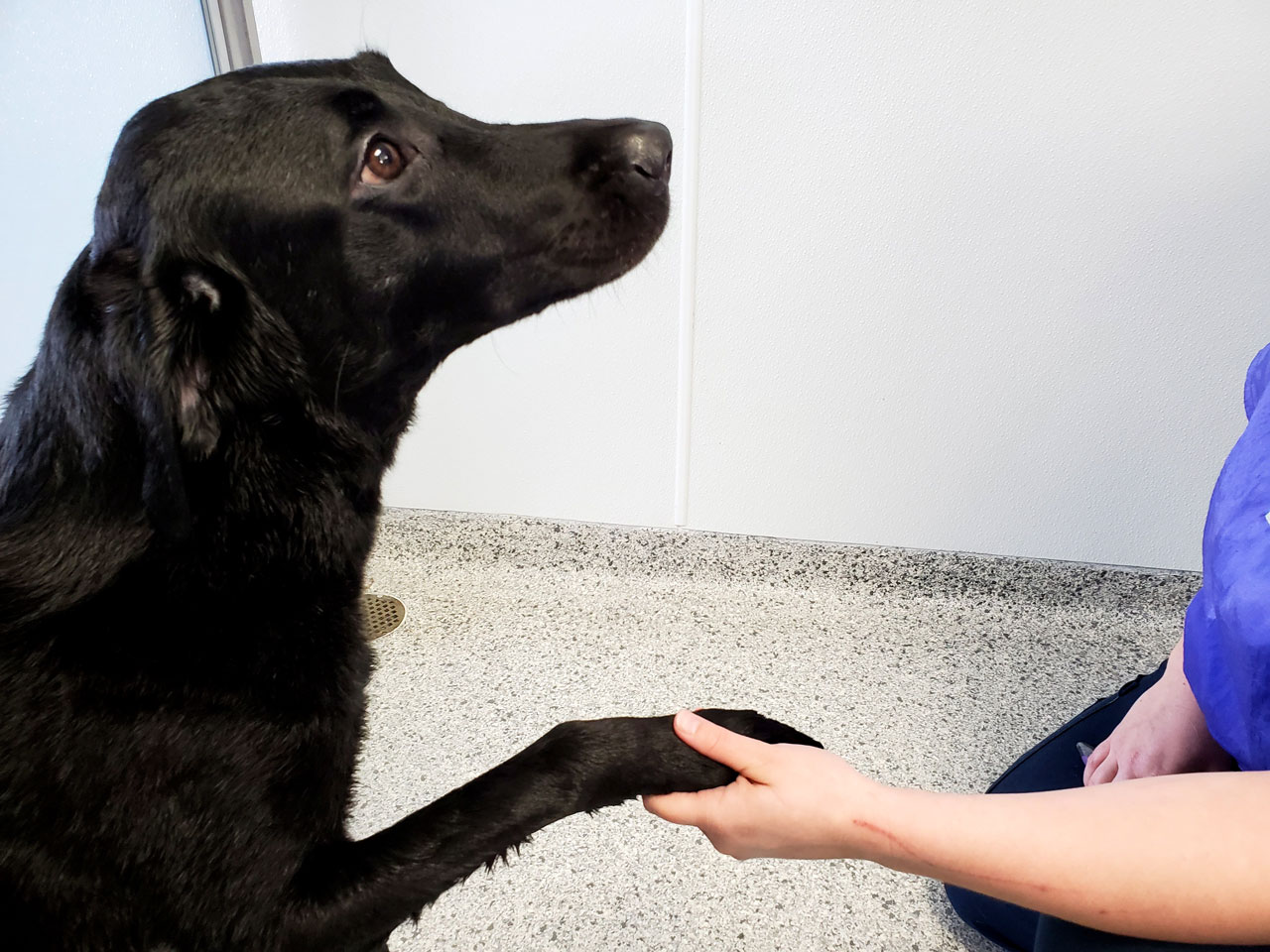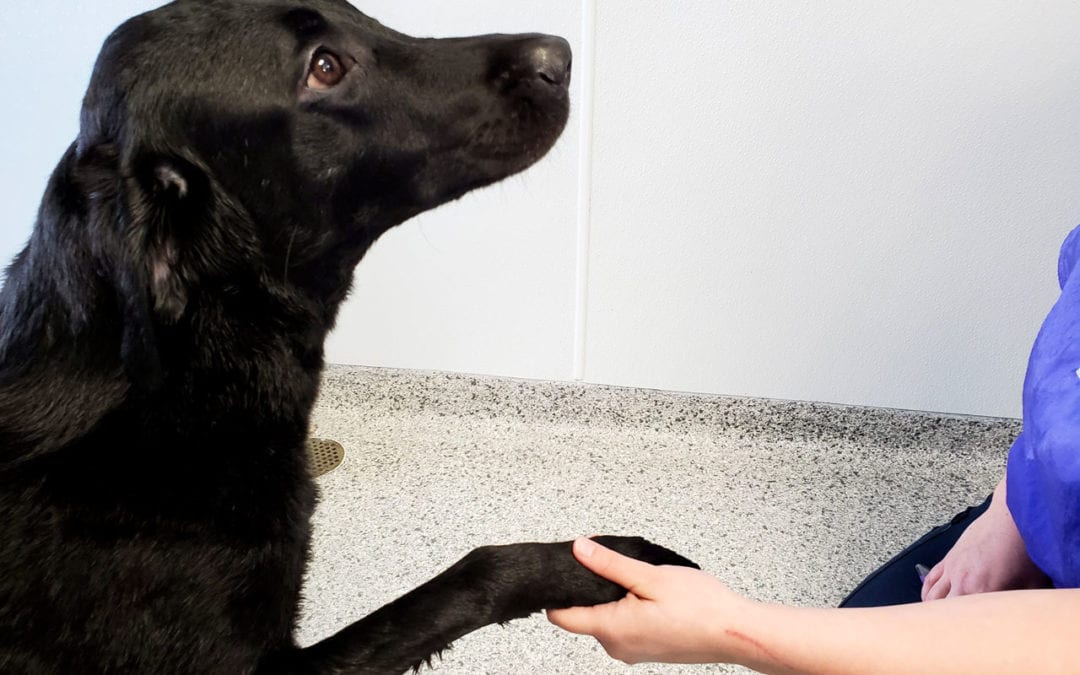Tell Me About: Nail Trimming

7 Steps to Take the Stress Out of Nail Trimming
Does your dog absolutely hate his/her nails being trimmed? If so, you are not alone. This is not an uncommon problem for pet owners. Fear and anxiety over nail trims can be a result of:
- An inherent dislike of people in their face or around their legs (some more than others)
- Negative experiences
- Pain
How does a nail trim result in a negative experience? Force. Using force to trim a dog’s nails only creates more anxiety and fear the next time you go to trim their nails. Forcing also creates future anxious and avoidant behavior. It really is no different than us! Imagine (and bear with me on this scenario- 😊) if every time someone shook your hand they pinched or tickled you. You would become extremely reluctant and it is likely that you would refuse to shake hands. Then, if the person persisted, you may even get angry (hopefully you don’t bite!). This is how some of our dogs feel.

To make matters worse, we cannot sit down with our dog to explain why we need to trim their nails.
Here is another scenario: what if you don’t like people shaking your hand but now they are offering you $10 for every handshake (positive reinforcement)? You may eventually let the reward overcome your discomfort. You try it once and you think that getting $10 was pretty nice (you enjoyed the Starbucks coffee… or the Chick-fil-A meal that you bought with it). The next time someone wanted to shake your hand, you were not nearly as anxious and you got another $10, and enjoyed the reward again! Repeat this process over and over and eventually you’ll begin to associate hand shaking with something to look forward to- you may be a millionaire by that time (ha)!
Our dogs are no different, really. It is possible to teach them to associate a nail trim with a positive experience. Yes, the training that I am about to share takes time- and a lot of work from you (this is part of the “why” veterinarians and grooming professionals charge for this service).
I hope you want to improve this process- and if you do, I encourage you to realize and accept that you are training your pet(s) to allow you (or someone else!) to trim their nails. This training is no different than teaching your pet to sit, lay down, stay, etc. There is no way to get around it: TRAINING TAKES TIME AND DEDICATION. While some pets are easier to train, others are definitely not and we may have a lot less hair when the process is complete!
7 Steps to Take the Stress out of Nail Trimming:
- DO NOT (and I actually mean DO NOT EVER!) hold your dog down to force your dog into a nail trim: This is a negative experience and will make the next nail trim even harder. This is as true for others as it is for you- even if they are professionals. Holding a pet down actually contributes to developed aggression and reactive biting.
- Talk to your vet: What if your dog’s nails need trimming and you don’t have time to go through the training process? I suggest that you talk with your vet to come up with a sedation plan. Depending on your pet’s anxiety it may just be a mild sedation (pills) and on the other end, it may need to be full-blown injectable sedation. Seek the best no anxiety/pain option- even if it does cost a little more.
- Build Patience: Choose to be A-OK with a little success at a time! This is true for you at home as well as if you are taking your dog somewhere to get his/her nails trimmed. If your veterinarian team is using a fear-free technique (treats and love), but they can only get 1 or 2 nails done- be okay with that. This is part of the time and process required to train a pet away from anxiety and toward acceptance! Yes, it will likely cost more, but you are building positive associations for your pet and eventually they will be okay with doing all the nails in one sitting.
- Plan ahead: Take time to figure out a reward system for your dog. This may be food, a good head rubbing, a toy, or play-time. It must be something that your pet really, really likes. Share this knowledge with your pet professionals as it will help them to be successful and in a partnership with you.
- Start at the very beginning: If your pet loves certain handling then start there. Be sure there is no anxiety present- touch the neck and down to the shoulder/knee and then give the earned reward. During other sessions, gradually work your way down your pet’s leg- easing your pet into knowing that everything is good! Set a goal of working on this 2-4 times a day for just 1-2 minutes. Short and frequent sessions are best! Eventually your pet will sit still, without any signs of stress, as your touch his/her feet (no lifting paws just yet!).
- One lift at a time (and have your pet’s reward ready!): Once you have accomplished step 5, move to picking up one foot (keep in mind- if your dog shows anxiety it is OK to go back to step 5). Have your pet’s award ready! Any and every time your pet allows you to lift a paw make sure to reward ASAP. You are teaching that it is ok to touch and handle your pet’s feet (goal time!) which must occur for a nail trim to happen. You can extend this to putting your fingers in between his/her toes. Depending on the dog this may be accomplished in 1 day or it may take weeks/months. In a nutshell we are training for the behavior we want using positive re-enforcement. Do not lose faith if it takes a while. Stick with it!
- Trimming time: If you and your pet have excelled with all the above steps you may then proceed to attempt to trim or file 1 or 2 nails. Stay alert for anxious behavior- but stay reassuring. If he/her gets fidgety it is best to stop and try again later. When trimming, start with the tip to avoid hurting your pet (black nails are tricky!). If you are not comfortable with nail clippers just use a nail file. A nail file will get your pet used to interaction with his/her nails and this makes it so much easier for everyone- you and your veterinarian team!
A word about being an advocate for your pet with your pet health care providers/groomers:
- Choose a facility that has certified Fear Free professionals, if at all possible. This will increase the likelihood of positive experiences (https://fearfreepets.com/)
- Be okay with using sedatives to help your pet through anxious or painful events- let your pet healthcare providers know this
- If your pet is being sedated for anything medical (i.e. a dental cleaning, mass removal, spay/neuter, etc.) ask that the nails be trimmed while your pet is asleep. This shouldn’t cost too much more and it is so much easier on everyone!
I sure hope that these 7 Steps to Take the Stress out of Nail Trimming help your home to have happier pets and humans! Anything and everything is possible with the right approach and attitude!
Dr. Robin Westwood, DVM

